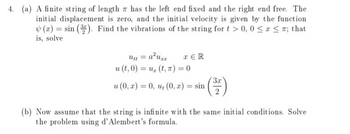
Advanced Engineering Mathematics
10th Edition
ISBN: 9780470458365
Author: Erwin Kreyszig
Publisher: Wiley, John & Sons, Incorporated
expand_more
expand_more
format_list_bulleted
Question
thumb_up100%

Transcribed Image Text:4. (a) A finite string of length 7 has the left end fixed and the right end free. The
initial displacement is zero, and the initial velocity is given by the function
(x) = sin (). Find the vibrations of the string for t > 0, 0≤x≤; that
is, solve
uμ = a²u₂ IER
u (t,0)=u, (t, x) = 0
u (0, x) = 0, u, (0, x) = sin
3x
(b) Now assume that the string is infinite with the same initial conditions. Solve
the problem using d'Alembert's formula.
Expert Solution
This question has been solved!
Explore an expertly crafted, step-by-step solution for a thorough understanding of key concepts.
Step by stepSolved in 7 steps with 7 images

Knowledge Booster
Similar questions
- 5. (а) Find the directional derivative of f at P in the direction of ā if f(x,y) = y In(x) ; P(1,4); ā = -3i +3j.arrow_forwardIf f(2) = 6, and f'(2) =-1.2, find the coordinates of points A, B, and C. Line segment BC is tangent to f(x) at point A. A y=f (x) 2arrow_forwardFind the slope of the tangent line to the curve 2(x + y)5 = y + 1 at the point (0,1). 5 2 [A] - // [C] - 1²/1 5 [B] - 17/0 [D] 10 9 [E] −1arrow_forward
arrow_back_ios
arrow_forward_ios
Recommended textbooks for you
 Advanced Engineering MathematicsAdvanced MathISBN:9780470458365Author:Erwin KreyszigPublisher:Wiley, John & Sons, Incorporated
Advanced Engineering MathematicsAdvanced MathISBN:9780470458365Author:Erwin KreyszigPublisher:Wiley, John & Sons, Incorporated Numerical Methods for EngineersAdvanced MathISBN:9780073397924Author:Steven C. Chapra Dr., Raymond P. CanalePublisher:McGraw-Hill Education
Numerical Methods for EngineersAdvanced MathISBN:9780073397924Author:Steven C. Chapra Dr., Raymond P. CanalePublisher:McGraw-Hill Education Introductory Mathematics for Engineering Applicat...Advanced MathISBN:9781118141809Author:Nathan KlingbeilPublisher:WILEY
Introductory Mathematics for Engineering Applicat...Advanced MathISBN:9781118141809Author:Nathan KlingbeilPublisher:WILEY Mathematics For Machine TechnologyAdvanced MathISBN:9781337798310Author:Peterson, John.Publisher:Cengage Learning,
Mathematics For Machine TechnologyAdvanced MathISBN:9781337798310Author:Peterson, John.Publisher:Cengage Learning,


Advanced Engineering Mathematics
Advanced Math
ISBN:9780470458365
Author:Erwin Kreyszig
Publisher:Wiley, John & Sons, Incorporated

Numerical Methods for Engineers
Advanced Math
ISBN:9780073397924
Author:Steven C. Chapra Dr., Raymond P. Canale
Publisher:McGraw-Hill Education

Introductory Mathematics for Engineering Applicat...
Advanced Math
ISBN:9781118141809
Author:Nathan Klingbeil
Publisher:WILEY

Mathematics For Machine Technology
Advanced Math
ISBN:9781337798310
Author:Peterson, John.
Publisher:Cengage Learning,

